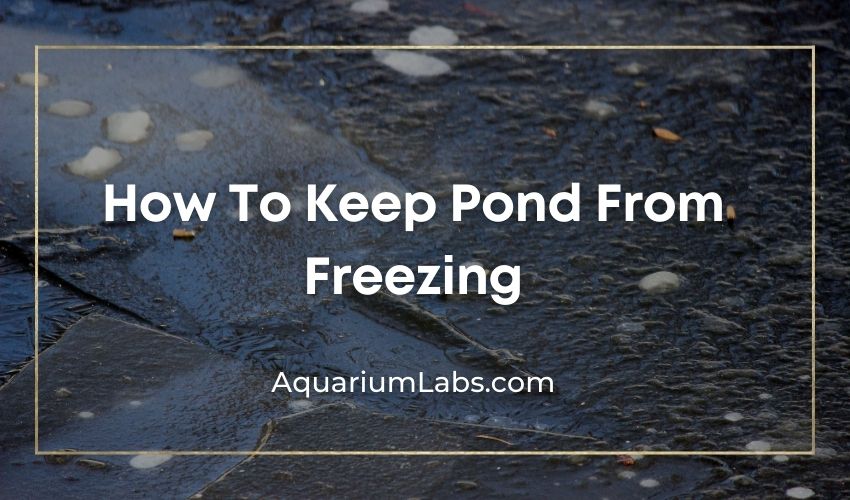Is your pond freezing quickly? Do you use too much electricity to prevent your pond from freezing?
Winter can be a challenge for pond owners in cold climates. Pond fish become less active during cold weather. As cold-blooded creatures, their metabolism drops dramatically when the temperature dips.
When this occurs, fish enter a state called “torpor.” This resting state is somewhat similar to hibernation. The heart rate of the fish slows down, they require less oxygen, little to no food, and their movement becomes sluggish or almost non-existent. This typically occurs when temperatures fall below 45-50F.
During this state, fish tend to migrate to the bottom of your pond, where the warmer water is. As long as the pond water doesn’t completely freeze, Koi and goldfish will remain in these warmer pockets of water and should be able to survive the winter.
Keeping a hole in the ice on our pond’s surface sounds like a simple and economical solution for many pond owners. However, it’s not a one-size-fits-all solution for every pond.
While you can prevent your pond from freezing without electricity, there are certain factors to consider before you decide to keep your pond from freezing. When you have fish in your pond, their survival depends on it.
This article will discuss what you need to know about keeping your pond from freezing.
Without pond fish, there’s no reason to keep your pond from freezing or leaving a hole in the ice. However, if your pond contains small fish like goldfish, it’s a good idea to take them inside to keep them warm during the winter.
Your pond’s location can also determine your decision. If your pond is likely to freeze intermittently during winter, perhaps for a day or two, you probably won’t have to worry about it freezing.
You should note that fish can survive for a relatively short period before getting cranky in a frozen pond. You can relieve their discomfort by pouring warm water on the ice to create a hole.
Keep in mind that you don’t need a large hole to keep your fish healthy. A hole the size of a dinner plate will work adequately to provide the oxygen fish need to ‘breathe’ and prevent them from getting sick or dying.
Ultimately, there’s no reason to worry about your pond freezing unless you keep fish in it. If so, you can keep it from freezing by following the appropriate steps.
Is it Possible to Keep a Pond From Freezing Without Electricity?
If you want to keep your pond from freezing, you must determine if it’s possible without electricity.
Someone with a pond in Little Rock, Arkansas, will find it easier to keep their pond from freezing than someone in Des Moines, Iowa.
This doesn’t mean that temperatures don’t drop to freezing levels in Arkansas or that Des Moines doesn’t have a warmer climate. It simply means that, on average, the temperature in Little Rock is much higher than in Des Moines.
You can check out the map to identify locations and areas where a pond can experience a prolonged freeze. Des Moines, for example, is considered a zone of 5a with an annual average temp of -15 to -20.
In contrast, Little Rock is an 8a zone with a minimum temp of 10 to 15. A higher zone means a lower chance of your pond freezing. Therefore, locations in zone 10 and above will likely not experience freezing.
You should know if your pond tends to freeze if you check it during winter and observe how long it remains frozen.
For example, if you’re in zone 6, use the guidelines to estimate whether or not your pond freezes for long periods.
How to Keep Ponds From Freezing
There are four main ways to prevent your pond from freezing that don’t require electricity. While these methods may not be completely foolproof, they’re effective when implemented under the right conditions.
However, always clean your pond before cold winter temperatures before implementing these methods. Remove organic debris such as leaves, sticks, algae, and sludgy residue on the bottom of your pond.
This is important because organic build-up consumes the oxygen your fish need to survive. To avoid multiple cleanings, use a pond vacuum, net, or rake to remove debris, ideally in the fall after the leaves have fallen.
Next, check your water quality to ensure ammonia, nitrates, nitrites, pond pH, and other levels are balanced.
Regarding feeding your fish, if the water temperature remains between 50-60F, feed once daily. For temperatures between 40-50F, feed once every other day. Once the temperature drops below 40F, stop feeding completely.
Once you’ve prepared the pond for the winter, consider the next steps to keeping it from freezing:
Pond Depth
The depth of your pond significantly determines if your pond will freeze. While a shallow pond might not experience instant freezing, a deep pond is better. Some fishes like Koi and goldfish can withstand cold water but not when the water completely freezes.
Always be aware of the best depth to prevent your fish pond from freezing. If your pond has Koi or other fishes, the minimum required depth is 18 inches.
However, a pond depth of 24 inches is the recommended depth, or even deeper, to be on the safe side. Remember, your fish won’t survive if the pond completely freezes.
Method 1: Pond Pumps
Running your pond pump during the winter is one way to help keep your pond from freezing in the winter.
Not only will the circulation of water help prevent the surface from completely freezing over, but water pumped through a mechanical or biological pond filter also improves water quality during the winter, providing a healthier environment for your fish.
Method 2: Solar Pond Aerator
Solar pond aerators are an extremely effective way to keep the temperature high if you live in regions with occasional temperature dips. Solar pond aerators can keep your pond from freezing and are ten times cheaper than electric pond heaters.
Solar pond aerators are effective during the day, but they won’t work at night without battery power. This leaves your pond to freeze overnight. A point to note about solar aerators is that even with the best models, it’s possible that the battery won’t work overnight.
Some pond aerators come with a backup battery of 132GPH that runs for 4 hours. This might be enough depending on your zone and nighttime temperatures.
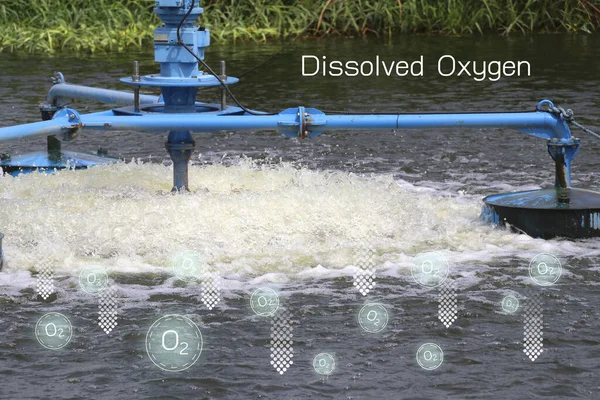
With enough time and adequate resources, it’s possible to build solar pond aerators capable of running 24hrs.
If you choose an aerator, make sure to place it near the shallow end of the pond. This makes it easier to maintain an open hole to allow oxygen into the pond and vent out carbon dioxide without disturbing the warmer water in deeper parts of the pond where fish would enter torpor.
You can also use submersible aerators for your pond. They’re most effective when submerged in the deepest part of the pond where there isn’t much circulating water, which helps prevent losing heat to the surface.
Method 3: Solar Pond Heater
A solar water heater is another effective way to heat your pond. While these heaters are mainly used for swimming pools, they can also be used in ponds to raise water temperatures in colder climates. When you install solar pond heaters, the pond pump releases hot water that prevents freezing.
Solar water heaters effectively circulate pond water through the panels. It uses the sun’s energy to retain warmth in both shallow and deeper ponds. The drawback is that the panel must be placed in direct sunlight for an extended period.
It won’t work effectively in zones with freezing temperatures and can’t heat your pond at night. You’ll also need to pump water into the solar heater and from the solar heater to the pond.
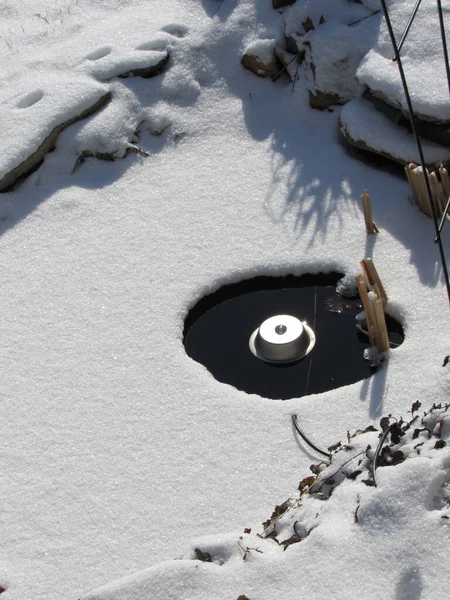
Method 4: Floating Devices
A smart option to keep your pond from freezing includes devices like floating saltwater bottles and ping pong balls. You can also include a floating ice preventer.
Besides preventing your pond from freezing, floating objects also help keep farm animal water tanks ice-free through constant movement.
The three floating device options have similar functions to keep your pond from freezing. When wind or bubbles from an aerator hit these devices, they constantly move and prevent the hole from freezing, much the way a river doesn’t freeze because of the movement of water.
Method 5: Adjust Your Filter and Keep It Working Well
Always maintain your filter to keep it working efficiently throughout the year, especially during winter. Filtering cleans the water, reduces fish waste, maintains a balanced pH, and reduces harmful gases. Water movement created by the filter also prevents the pond from freezing.
Position the filter outlet, so water flows horizontally and avoids feeding cold water throughout the bottom of the pond. This method keeps warm water below the surface while keeping cold water at the surface to create a safe, comfortable environment for your fish.
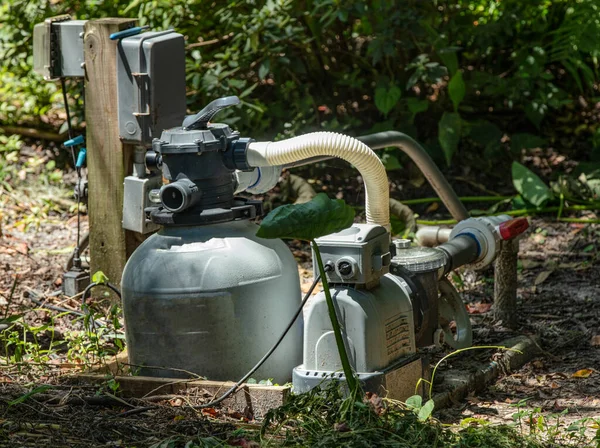
Turn off fountains and waterfalls in the winter. These are only useful for keeping your fish cool in the summer.
Method 6: Cover Your Garden Pond
Another way to keep your pond from freezing is to cover it with a pre-made cover, net, tarp, or bubble wrap that can be stretched over the pond.
Covering your pond depends on the size and shape of the pond. Smaller ponds are more likely to freeze, but they’re easier to cover.
Covers are also useful in preventing debris from falling into the pond during the winter, where it can be trapped beneath the ice, foul the water, and potentially reduce oxygen levels.
You can also cover the pond to trap warmth on sunny days and retain this warmth during winter, which creates a greenhouse effect. Floating plants are another effective way to keep the pond from freezing.
Method 7: Polystyrene Ice Preventer
Looking for a cheap way to keep your pond warm during winter? Use a polystyrene ice preventer to protect your pond from freezing.
It works with an air pump to create bubbles circulating throughout the bottom of the pond to keep the water from freezing. It’s a cheaper alternative to your heater but may not be the most effective option during a harsh winter.
Method 8: Invest in Pond Heaters
If you want to use electricity to keep your pond from freezing, pond heaters are available in different sizes and models depending on pond water volume or depth.
Some pond heaters float and defrost certain areas to release gases. Others heat all the pond water and are your best bet if you have fussy fish.
Smaller heaters float on the surface and have a heating element to defrost small areas. They have a long power cord that can be connected to an external electrical outlet. It’s not necessary to run them overnight except during the coldest conditions.
Another option is a heater system that slots directly into a hose between the pond pump and filter, which heats your water. A heater with 1 kilowatt heats 1000 liters of water.
While it can be expensive to run all the time, you only need to run it long enough to prevent the water from freezing.
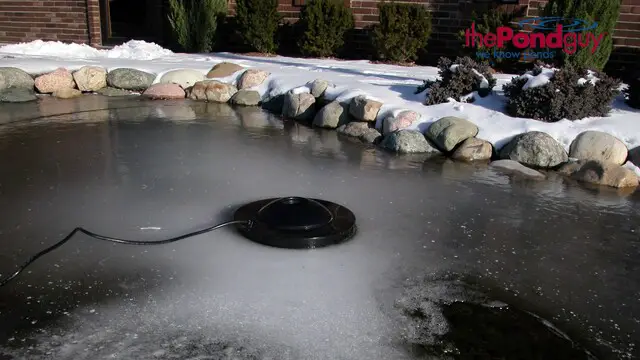
Newer models have a thermostat allowing you to turn the heater on and off when it reaches the desired temperature to help you conserve power.
Your choice of wattage depends on the volumes of the pond and your freeze zone. Most heaters come with a recommendation on how low the temp can dip and still run effectively.
It’s always a good idea to check your pond temperature to make it’s at the correct temperature to make sure the heater is doing its job.
While some pond owners prefer to prevent freezing without electricity, it ultimately depends on the temperatures in your zone.
Other Tricks You Can Try:
Try different methods to achieve the best results. You can connect a floating device with a solar aerator. When the aerator releases bubbles, set the floating balls in motion to prevent the pond from freezing.
If your pond does freeze, avoid breaking the surface with a hammer or other heavy object, which can stress your fish. Don’t use boiling water to create a hole. Heat a saucepan of water in the morning and place it on the surface until it defrosts a hole in the ice.
In addition to a properly functioning filter, pond owners can adjust the flow to create a warm water pool below the surface. Your fish will gather here once the water drops below 4 degrees, making it more comfortable.
How Cold Must It Be to Freeze a Pond?
You can typically expect to see your pond covered in a thin sheet of ice after two weeks of freezing temperatures.
However, before your pond freezes, the water must cool to 39.2 degrees. Water deeper than 24 inches may not freeze because the volume won’t reach a cold enough temperature.
It takes quite some time for a 4-inch sheet of ice to form on the surface of your pond. Water gets denser and heavier as it cools, so water freezing from surface to bottom is critical for aquatic life to survive.
Conclusion
If your pond has been frozen for more than two days, your fish can be affected by a lack of oxygen and exposure to toxic gases.
The point of having a pond is to enjoy the serenity of the water and the beauty of fish and plants in a natural environment, so caring for your pond in the winter is simply a sensible investment.
Fortunately, you have many options to keep your pond from freezing. Some are more expensive, but you’ll find enough choices to fit your budget and suit the size of your pond and the type of fish you keep.
Related Interesting Reads:

